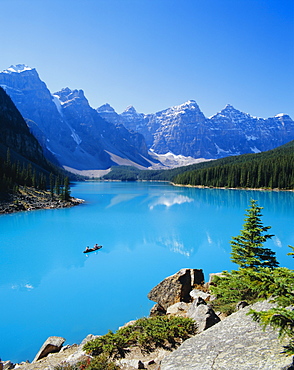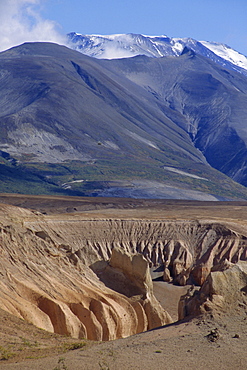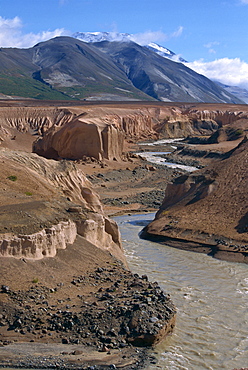Recent searches
Loading...
979-7139 - Chinstrap penguin (Pygoscelis antarctica) chick head detail at colony on Useful Island near the Antarctic Peninsula. There are an estimated 2 million breeding pairs of chinstrap penguins in the Antarctic peninsula region alone, perhaps as many as 7.5 million breeding pairs in all of Antarctica. Their name derives from the narrow black band under their heads which makes it appear as if they are wearing black helmets, making them one of the most easily identified types of penguin. Other names for them are "Ringed Penguins", "Bearded Penguins", and "Stonecracker Penguins" due to their harsh call. They grow to 68 cm (27 in). The average adult weight of a Chinstrap Penguin is 4.5 kg (10 lbs). Weight can range from 3 to 6 kg (6.6-13.2 lbs), with males being slightly larger and weight varying based on where the penguin is in the breeding cycle. Their diet consists of krill, shrimp, and fish. On land they build circular nests from stones, and lay two eggs, which are incubated by both the male and the female for shifts of five to ten days. They can also breed on icebergs, though they prefer non-icy conditions. The chicks hatch after about 35 days, and have fluffy gray backs and white fronts. The chicks stay in the nest for 20?30 days before they go to join a creche. At around 50?60 days old, they moult, gaining their adult plumage and go to sea. The Chinstrap Penguin was first described by German naturalist Forster in 1781. Its specific epithet was often seen as antarctica, however a 2002 review determined the genus Pygoscelis was masculine, and hence the correct binomial name is Pygoscelis antarcticus.
911-5815 - Build up of algae due to low water levels at Lake Eildon after an uprecedented ten years of drought, with only 29 percent capacity, Victoria, Australia, Pacific
911-5861 - Trees drowned when Lake Eildon reservoir was first filled now stand well clear of the water after an uprecedented ten years of drought, Victoria, Australia, Pacific
911-5813 - Trees drowned when Lake Eildon reservoir was first filled now stand well clear of the water after an uprecedented ten years of drought, Victoria, Australia, Pacific
911-5814 - Off road vehicle at Lake Eildon after an uprecedented ten years of drought, with only 29 percent capacity, Victoria, Australia, Pacific
911-5812 - Trees drowned when Lake Eildon reservoir was first filled now stand well clear of the water after an uprecedented ten years of drought, Victoria, Australia, Pacific
911-6598 - A poster about the benefits of cycling, United Kingdom, Europe
911-5858 - Trees drowned when Lake Eildon reservoir was first filled now stand well clear of the water after an uprecedented ten years of drought, Victoria, Australia, Pacific
911-5860 - Trees drowned when Lake Eildon reservoir was first filled now stand well clear of the water after an uprecedented ten years of drought, Victoria, Australia, Pacific
911-5859 - Trees drowned when Lake Eildon reservoir was first filled now stand well clear of the water after an uprecedented ten years of drought, Victoria, Australia, Pacific
911-5863 - Trees drowned when Lake Eildon reservoir was first filled now stand well clear of the water after an uprecedented ten years of drought, Victoria, Australia, Pacific
911-5857 - Trees drowned when Lake Eildon reservoir was first filled now stand well clear of the water after an uprecedented ten years of drought, Victoria, Australia, Pacific
911-5811 - Off road vehicle tracks at Lake Eildon after an uprecedented ten years of drought, with only 29 percent capacity, Victoria, Australia, Pacific
805-289 - Hindu musician dressed in orange clothing playing ten scale Indian harmonium keyboard, West Bengal, India, Asia
832-27964 - Blonde girl standing on the beach, smiling, holding a fishing net and a starfish
832-10735 - Eagle Ray (Myliobatidae) being fed, Discovery Cove, Orlando, Florida, USA, North America
832-10734 - Eagle Ray (Myliobatidae) being fed, Discovery Cove, Orlando, Florida, USA, North America
797-7984 - Turkey, Izmir Province, Selcuk, Ephesus, Sign advertising Genuine Fake Watches and ten Euro price ticket
834-5824 - Incense urn, Ten Thousand Buddha Monastery Pagoda, a monastery housing over 12800 statues of the Buddha, Sha Tin, New Territories, Hong Kong, China, Asia
834-5823 - Ten Thousand Buddha Monastery Pagoda, a monastery housing over 12800 statues of the Buddha, Sha Tin, New Territories, Hong Kong, China, Asia
834-5825 - Detail of lion statue, Ten Thousand Buddha Monastery Pagoda, a monastery housing over 12800 statues of the Buddha, Sha Tin, New Territories, Hong Kong, China, Asia
834-512 - Shuen-sanzi-ten Temple, Kaohsiung, Taiwan, Asia
834-5826 - Buddha statue in the Ten Thousand Buddha Monastery, which houses over 12800 Buddha statues, Sha Tin, New Territories, Hong Kong, China, Asia
834-513 - Roof detail at Shuen-sanzi-ten Temple, Kaohsiung, Taiwan, Asia
809-3612 - Sheikh Zayed Grand Mosque, the biggest mosque in the U.A.E. and one of the ten largest mosques in the world, Abu Dhabi, United Arab Emirates, Middle East
809-3613 - Sheikh Zayed Grand Mosque, the biggest mosque in the U.A.E. and one of the ten largest mosques in the world, Abu Dhabi, United Arab Emirates, Middle East
817-8134 - Huis Ten Bosch (Dutch village), Nagasaki, Kyushu, Japan
817-8132 - Huis Ten Bosch (Dutch village), Nagasaki, Japan
809-2222 - Painting of herding the Ox, from the ten Ox Herding Pictures of Zen Buddhism, representing the stages of enlightement, Seoul, South Korea, Asia
809-2223 - Painting of catching the Ox, from the ten Ox Herding Pictures of Zen Buddhism, representing the stages of enlightement, Seoul, South Korea, Asia
809-2221 - Painting of coming home on the Ox's back, from the ten Ox Herding Pictures of Zen Buddhism, representing the stages of enlightement, Seoul, South Korea, Asia
797-6473 - Donegall Quay The Big Fish Sculpture by John Kindness, The scales of the fish are pieces of printed blue tiles with details of Belfasts history, Ireland
238-5787 - The Dynastic Temple (The Mieu), dedicated to ten Nguyen Emperors, The Citadel, Hue, UNESCO World Heritage Site, Vietnam, Indochina, Southeast Asia, Asia
797-3522 - CROATIA Istria Buzet CrBuzet Subotina festival/giant omelette preparation.The highlight of the Buzet Subotina festival held every September is the preparation of a giant truffle omelette using over two thousand eggs and ten kilos of truffles. The area around Buzet is one of Europes prime locations for finding the gourmet fungus Croatian cuisine
17-85 - Painting clay based image of Durga, the ten armed warrior goddess, for use in the Durga Puja festival, Varanasi, Uttar Pradesh, India, Asia
17-84 - Clay based images of Durga, the ten armed warrior goddess, for use in the Durga Puja festival, Varanasi, Uttar Pradesh, India, Asia
17-1444 - Making clay based image of Durga, the ten armed warrior goddess, for use in the Durga Puja festival, Varanasi, Uttar Pradesh, India, Asia
17-1214 - Temple priest before the image of the ten armed warrior goddess Durga, Durga Puja Festival, Varanasi, Uttar Pradesh state, India, Asia
17-1211 - Dancing before the image of the ten armed warrior goddess Durga, Durga Puja Festival, Varanasi, Uttar Pradesh state, India, Asia
752-1523 - Clouds over snowcapped mountains, Valley Of The Ten Peaks, Banff National Park, Alberta, Canada
396-906 - Moraine Lake, Valley of Ten Peaks, Banff National Park, Rocky Mountains, Alberta, Canada
396-926 - Valley of the Ten Peaks, Lake Moraine, Rocky Mountains, Banff National Park, Alberta, Canada
645-2164 - Ban Po Tha Pagoda (Ten thousand Buddhas), Kek Lok Si Temple, Penang, Malaysia, Asia
29-1828 - Griggs volcano overlooks Valley of Ten Thousand Smokes filled by ash in 1912 eruption of Katmai, Katmai Volcano National Park, Alaska, USA, North America
29-1818 - Valley of Ten Thousand Smokes with ignimbrite of 1912 eruption, Griggs volcano behind, Katmai National Park, Alaska, USA, North America
29-4278 - Blocks of flats beside road to Nampo, ten lanes wide but no traffic, Pyongyang, North Korea, Asia
396-1139 - Valley of Ten Peaks, Moraine Lake, Banff National Park, Rocky Mountains, Alberta, Canada, North America
29-4276 - Blocks of flats beside road to Nampo, ten lanes wide but no traffic, Pyongyang, North Korea, Asia
462-811 - Exterior of the Ban Po Tha Pagoda (Ten thousand Buddhas), Kek Lok Si Temple, Penang, Malaysia, Asia
396-880 - Valley of the Ten Peaks, Moraine Lake, Banff National Park, Rocky Mountains, Alberta, Canada, North America
396-905 - Lake Moraine, Valley of the Ten Peaks, Banff National Park, Alberta, Canada
391-7259 - Bird mosaic on floor of Roman basilica of the 5th century AD in Soli, one of Cyprus's ten ancient city kingdoms, founded in the 6th century BC, Soli, North Cyprus, Europe
142-3374 - Crowds wearing red and pink umbrella hats during the annual Double Ten National Day in Taipei, Taiwan, Asia
396-931 - Moraine Lake, Valley of the Ten Peaks, Banff National Park, UNESCO World Heritage Site, Rocky Mountains, Alberta, Canada, North America
255-8558 - Ten Penny cottage, Boat Lane in the village of Welford on Avon, Warwickshire, England, United Kingdom, Europe
29-1822 - Ignimbrite exposed in river canyons cut since 1912 eruption, in the Valley of Ten Thousand Smokes, in Katmai Volcano National Park, Alaska, United States of America, North America
188-1097 - Tang statue at the Chunling Tombs, ten kilometers northwest of Xian, China, Asia
390-2130 - Path on bank of Ten Foot Pond, Sheffield Park Garden, East Sussex, England, United Kingdom, Europe
29-4653 - Moraine Lake with mountains that overlook Valley of the Ten Peaks, Banff National Park, Canada, North America
83-12101 - Restored wall with mythical bird motif in the Tschudi Complex, one of the ten 'ciudadelas' at Chan Chan, pre-Columbian America's largest adobe city and capital of the Chimu Empire until its 14th century conquest by the Incas, Chan Chan, UNESCO World Heritage Site, Moche Valley, Trujillo, Peru, South America
83-12100 - Mythical bird motif in the Tschudi Complex, one of the ten 'ciudadelas' at Chan Chan, pre-Columbian America's largest adobe city and capital of the Chimu Empire until its 14th century conquest by the Incas, Chan Chan, UNESCO World Heritage Site, Moche Valley, Trujillo, Peru, South America
83-12104 - Entrance in the Tschudi Complex, one of the ten 'ciudadelas' at Chan Chan, pre-Columbian America's largest adobe city and capital of the Chimu Empire until its 14th century conquest by the Incas, Chan Chan, UNESCO World Heritage Site, Moche Valley, Trujillo, Peru, South America
83-12106 - Restored wall with mythical bird motif in the Tschudi Complex, one of the ten 'ciudadelas' at Chan Chan, pre-Columbian America's largest adobe city and capital of the Chimu Empire until its 14th century conquest by the Incas, Chan Chan, UNESCO World Heritage Site, Moche Valley, Trujillo, Peru, South America
83-12107 - Restored wall with mythical bird motif in the Tschudi Complex, one of the ten 'ciudadelas' at Chan Chan, pre-Columbian America's largest adobe city and capital of the Chimu Empire until its 14th century conquest by the Incas, Chan Chan, UNESCO World Heritage Site, Moche Valley, Trujillo, Peru, South America
83-12105 - Restored wall with mythical bird motif in the Tschudi Complex, one of the ten 'ciudadelas' at Chan Chan, pre-Columbian America's largest adobe city and capital of the Chimu Empire until its 14th century conquest by the Incas, Chan Chan, UNESCO World Heritage Site, Moche Valley, Trujillo, Peru, South America
83-12095 - Statue in the Tschudi Complex, one of the ten 'ciudadelas' at Chan Chan, pre-Columbian America's largest adobe city and capital of the Chimu Empire until its 14th century conquest by the Incas, Chan Chan, UNESCO World Heritage Site, Moche Valley, Trujillo, Peru, South America
83-12102 - Statue in the Tschudi Complex, one of the ten 'ciudadelas' at Chan Chan, pre-Columbian America's largest adobe city and capital of the Chimu Empire until its 14th century conquest by the Incas, Chan Chan, UNESCO World Heritage Site, Moche Valley, Trujillo, Peru, South America
83-12098 - 'Audiencias', possibly administrative offices of the elite, in the Tschudi Complex, one of the ten 'ciudadelas' at Chan Chan, pre-Columbian America's largest adobe city and capital of the Chimu Empire until its 14th century conquest by the Incas, Chan Chan, UNESCO World Heritage Site, Moche Valley, Trujillo, Peru, South America
83-12099 - 'Audiencias', possibly administrative offices of the elite, in the Tschudi Complex, one of the ten 'ciudadelas' at Chan Chan, pre-Columbian America's largest adobe city and capital of the Chimu Empire until its 14th century conquest by the Incas, Chan Chan, UNESCO World Heritage Site, Moche Valley, Trujillo, Peru, South America
83-12096 - Restored wall with fish motif in the Tschudi Complex, one of the ten 'ciudadelas' at Chan Chan, pre-Columbian America's largest adobe city and capital of the Chimu Empire until its 14th century conquest by the Incas, Chan Chan, UNESCO World Heritage Site, Moche Valley, Trujillo, Peru, South America
83-12103 - Statue in the Tschudi Complex, one of the ten 'ciudadelas' at Chan Chan, pre-Columbian America's largest adobe city and capital of the Chimu Empire until its 14th century conquest by the Incas, Chan Chan, UNESCO World Heritage Site, Moche Valley, Trujillo, Peru, South America
83-11832 - The 2400 megawatt Navajo Generating Station. It's coal fuel comes from Kayenta Mine and cooling water from the nearby dammed Lake Powell. One of the top ten US generators, Glen Canyon, Arizona, USA
You reached the end of search results








































































